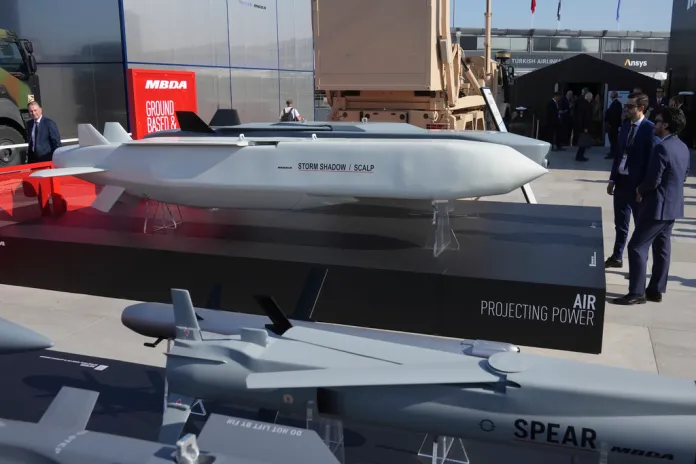The United States has reportedly removed restrictions on using its targeting data for sites inside Russia.
A person familiar with discussions told the Wall Street Journal that the decision was made before Ukrainian President Volodymyr Zelensky went to the White House to meet with President Donald Trump, where the two had a heated meeting ending in Trump warning that Russia could “destroy” Ukraine. This means the decision was unrelated to a brief revival and then collapse in Russia-U.S. rapprochement last week, up until Tuesday, when a meeting between Trump and Russian President Vladimir Putin was planned in Budapest, then put on ice.

The first move against Russia after the planned meeting collapsed was sanctions targeting Russia’s two largest oil companies, Open Joint Stock Company Rosneft Oil Company (Rosneft) and Lukoil OAO (Lukoil), which were both designated.
“Now is the time to stop the killing and for an immediate ceasefire,” Treasury Secretary Scott Bessent said in a statement. “Given President Putin’s refusal to end this senseless war, Treasury is sanctioning Russia’s two largest oil companies that fund the Kremlin’s war machine. Treasury is prepared to take further action if necessary to support President Trump’s effort to end yet another war. We encourage our allies to join us in and adhere to these sanctions.”
Speaking to reporters on Wednesday alongside NATO head Mark Rutte, Trump said he put the sanctions in place because he “just felt it was time.”
He also said he didn’t have a time frame for the war’s end.
The meeting with Putin was “canceled” because “it just didn’t feel right to be. It didn’t feel like we were going to get to the place we have to get. So I canceled it, but we’ll do it in the future,” Trump said.
In a statement to the Washington Examiner, the White House avoided directly confirming it had removed restrictions on using Western cruise missiles inside Russia, instead outlining Trump’s efforts to end the war.
“This is a war that never would have happened had President Trump been President, something President Putin himself acknowledged, and President Trump is trying to get it stopped. The President also negotiated a historic agreement to allow NATO allies to purchase American-made weapons. We do not have further announcements at this time,” the official said.
ZELENSKY HOPES RUSSIA’S STALLING TACTICS CAN REVIVE TOMAHAWK NEGOTIATIONS
Trump himself reacted angrily to the Wall Street Journal report, calling it “FAKE NEWS!”
“The Wall Street Journal story on the U.S.A.’s approval of Ukraine being allowed to use long range missiles deep into Russia is FAKE NEWS! The U.S. has nothing to do with those missiles, wherever they may come from, or what Ukraine does with them!” he said in a post on Truth Social.
The Pentagon directed the Washington Examiner to Trump’s statement when asked for comment.
The president elaborated during his press conference with Rutte.
“No, it said that I gave Ukraine permission to shoot missiles deep into Russia. I didn’t do that. Second of all, they’re not using our missiles. They’re using, I think, European missiles … but they’re not using ours. And what they do, I don’t control that, but I do control our missiles. They’re not shooting our missiles, and it was a fake story,” he said.
The reported move doesn’t entail the delivery of new, longer-range weapons. Former President Joe Biden briefly allowed Ukraine to fire long-range cruise missiles against targets in Russia during his lame duck period, but this was retracted after Trump took office. The Pentagon set up a review procedure requiring War Secretary Pete Hegseth’s direct approval for strikes against Russian targets, approval that was never granted. At an undisclosed recent point, authority was turned over to European Command, two U.S. officials told the Wall Street Journal.
The move won’t allow Ukrainian strikes deep inside Russia, as the only Western missiles in its current possession have ranges of under 200 miles. However, even Western cruise missiles not under U.S. control, like the United Kingdom’s Storm Shadow, rely on U.S. targeting data to hit Russian targets, data that weren’t previously provided.
Ukraine only has a few ATACMS left, U.S. missiles with a range of about 180 miles. Other U.S. long-range missiles recently approved for Ukraine’s use, Extended Range Attack Munition air-launched missiles, or ERAMs, have a maximum range of about 280 miles. Altogether, these missiles launched at targets within Russia may be able to disrupt Russian logistics or hit command-and-control centers, but don’t have the range to take part in Ukraine’s recent effective strikes against Russian oil refineries, located far away from the border. To do this, Ukraine would need U.S. Tomahawk missiles, which Trump refused to give on Friday.
With a range of roughly 780 to 1,550 miles, depending on the variant, the Tomahawk is the longest-range missile in NATO’s arsenal that can be realistically given to Ukraine. Moscow and St. Petersburg are well within range of the powerful missile, hypothetically allowing Kyiv to hit the Kremlin itself. Zelensky alluded to the possibility in an interview last month.
However, experts warn that there are severe limitations on Tomahawk missiles. Mark Cancian, a former Pentagon official now at the Center for Strategic and International Studies think tank, estimated in a recent war game that the total number of Tomahawk missiles in the U.S. arsenal stands at about 4,150, the Financial Times reported. The Pentagon has already fired over 120 of the 200 it has procured since 2022.
Stacie Pettyjohn, director of the defense program at the Center for a New American Security think tank, told the Financial Times that the U.S. could realistically only supply about 20 to 50 Tomahawk missiles to Ukraine. Such a number “will not decisively shift the dynamics of the war.”
Kyiv could mix in the missiles with its other long-range drones in complex strikes to try to overwhelm Russian air defenses, but they “still will be a very limited capability … certainly not enough to enable sustained, deep attacks against Russia.”
Ukraine also faces the significant problem of how to launch the missiles. The Tomahawk has primarily been fired from naval platforms, with all combat uses coming from submarines or surface ships. The U.S. recently developed and launched the Typhon launcher for this purpose, but the large, clunky platform would be a primary target for Russian missiles and drones.
Trump said there was a “tremendous learning curve” to use the Tomahawks, saying it would take “at least a year” to learn how to use them. The only way for Ukraine to use them soon was if the U.S. would fire them, he argued, which wasn’t going to happen.
WHY DOES UKRAINE WANT THE US TO SUPPLY IT WITH TOMAHAWKS?
Despite these hangups, Kyiv is hoping the psychological factor alone could help change Moscow’s calculus and bring it to the negotiating table. Despite Trump’s refusal on Friday, Zelensky voiced hope on Tuesday that the failure to set up another meeting between Putin and Trump could change the president’s mind on sending Tomahawks.
“The front line can spark diplomacy. Instead, Russia continues to do everything to weasel out: as soon as the issue of long-range capabilities for Ukraine became less immediate, their interest in diplomacy faded,” Zelensky said. “This signals that deep strike capabilities may hold the key to peace.”























